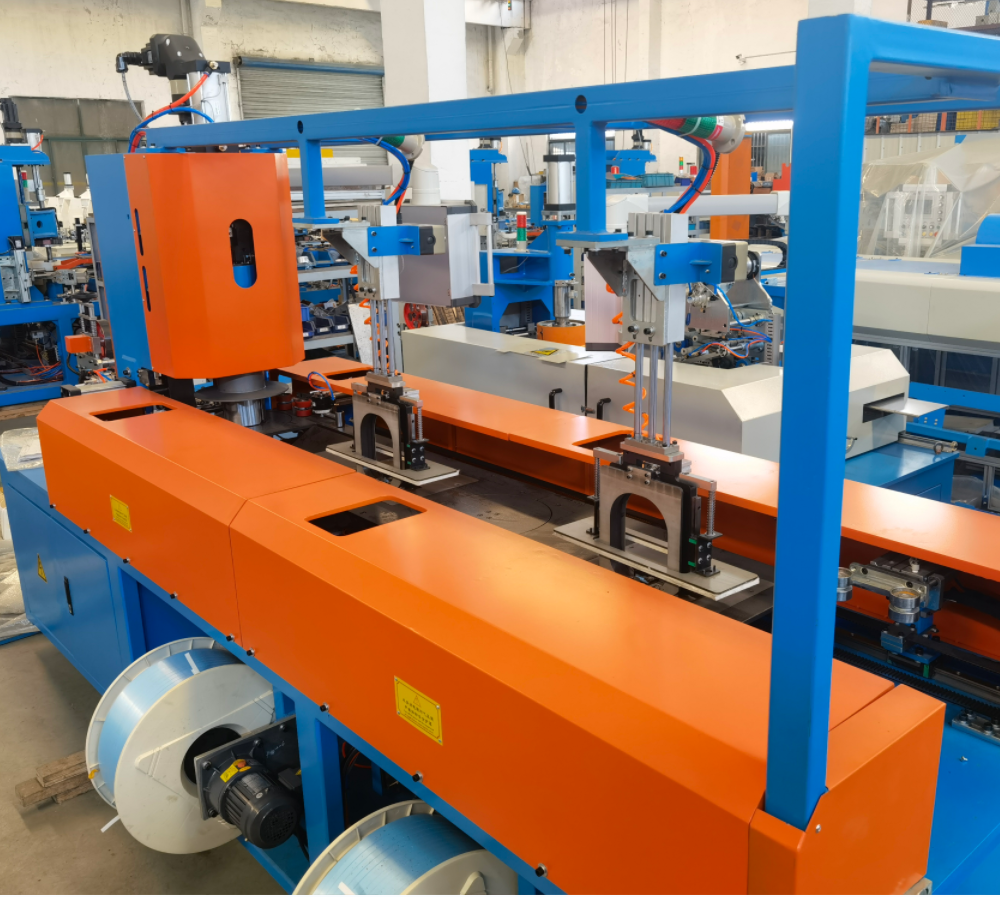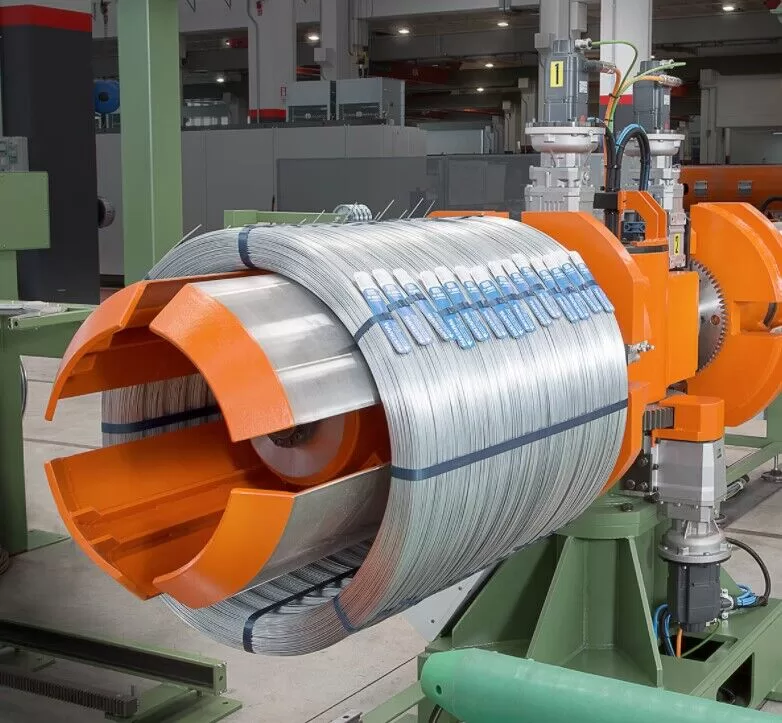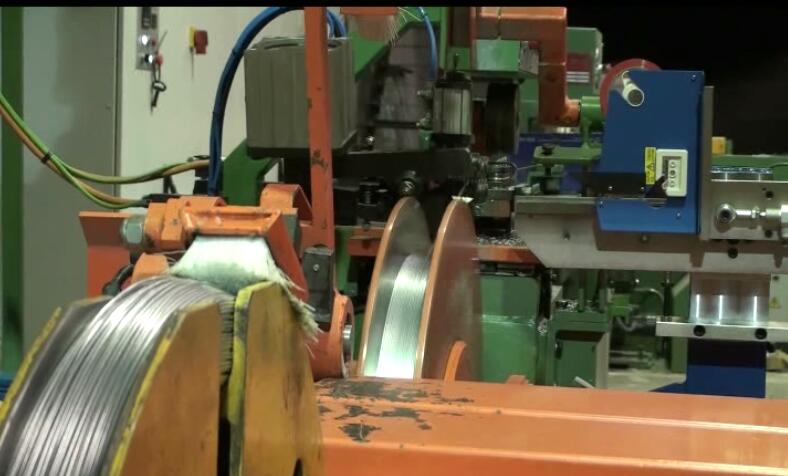Are you struggling to maintain efficiency when your production line has to handle multiple steel wire sizes? One moment you're running thin, delicate wire, and the next, you're coiling heavy-gauge steel. This constant switching can create massive bottlenecks. The setup for one size is wrong for the next, leading to inconsistent coil quality, snapped wires, or loose, unstable coils. It feels like a never-ending battle to keep up, and every minute of downtime or scrapped material eats directly into your profits. You know there has to be a better way than constantly fighting your own equipment.
Optimizing a steel wire coiling machine for variable sizes requires a combination of a versatile coiling head, a dynamic tension control system, and pre-programmed settings for quick changeovers. The most crucial elements are mechanically adjustable guides that prevent wire damage, a responsive motor-driven tension system that adapts to different wire strengths in real-time, and an intuitive HMI controller. This controller should allow operators to save and instantly recall all parameters for each wire specification, turning a complex changeover into a simple, one-touch process.

This isn't just theory from a textbook. I've lived these challenges. My name is Vincent LIU, and I built my career from the ground up, starting as an engineer on the factory floor and eventually building my own successful packing machine factory. I've seen firsthand how the wrong equipment can cripple an operation and how the right solution can unlock incredible growth. Let’s walk through the practical steps and key components that will solve this problem for good.
How Do You Choose the Right Coiling Head and Tension Control for Different Wires?
You’ve invested in a new coiling machine, but you're still facing the same old problems. The coils for your thick wires are perfect, but when you switch to a thinner gauge, the wire gets scraped, tangled, or even snaps under the tension. Your operators are constantly adjusting the machine by hand, trying to find a sweet spot that doesn't exist. This constant struggle leads to piles of scrapped wire, unhappy customers complaining about damaged products, and a production team that is completely frustrated. You're losing money and morale.
To solve this, you must select a coiling head and tension control system specifically designed for your full range of wire diameters. A suitable coiling head will have easily adjustable or interchangeable formers and guides to handle different sizes without causing friction or damage. For tension, a dynamic system is non-negotiable. This means using a servo motor-driven dancer arm or a precise electronic brake that automatically adjusts tension based on real-time feedback. This ensures you get tight, consistent winding on heavy-gauge wires and gentle, smooth winding on fine wires, all from the same machine.

The Heart of the Machine: Coiling Head and Traverse System
The coiling head is where the physical coil takes shape. A one-size-fits-all approach simply doesn't work here. If the forming pins or mandrel are too large for a thin wire, the coil will be loose and unstable. If the guides are too tight for a thick wire, you'll get surface scratches and damage. This is why adaptability is so important.
A good machine offers options. For factories with a few standard sizes, quick-change mandrels can be a great solution. An operator can swap them out in minutes. For operations with a very wide and unpredictable range of sizes, a collapsible coiling head is better. It can be adjusted to a specific inner diameter without a full tool change. The traverse winder, the part that moves back and forth to lay the wire evenly, is just as important. It must be synchronized perfectly with the coiling speed. For variable wire sizes, the traverse pitch (how far it moves per rotation) needs to be adjustable. A simple setting on the HMI should control this, ensuring a tight, level wind whether the wire is 1mm or 10mm thick.
The Unsung Hero: Dynamic Tension Control
In my early days running a factory, we tried to save money by using a machine with a simple mechanical friction brake for tension. It worked okay for one specific wire size. But any time we changed the product, it was a disaster. Thin wires would stretch and snap. Thick wires would unwind the second they were taken off the machine. We lost a significant order because we couldn't guarantee consistent coil quality.
That experience taught me a valuable lesson: tension control is not a place to cut corners. A modern system uses a servo motor connected to a dancer arm. This arm moves up and down based on the wire's tension. The servo motor instantly adjusts its speed or torque to keep the dancer arm, and therefore the wire tension, perfectly stable. This active, closed-loop feedback system is incredibly precise. It can apply strong tension for heavy wires and then, with a simple change in the settings, apply delicate tension for fine wires. The result is a perfect coil every single time, regardless of the size. The investment pays for itself quickly through reduced scrap, higher quality, and increased throughput.
| Feature | Basic System (Mechanical Brake) | Advanced System (Servo Dancer) |
|---|---|---|
| Precision | Low. Relies on friction, inconsistent. | High. Real-time electronic adjustment. |
| Adaptability | Poor. Requires manual re-adjustment for each wire. | Excellent. Changes tension via HMI recipe. |
| Wire Damage Risk | High. Can easily stretch or snap thin wires. | Low. Gentle on all wire types. |
| Consistency | Poor. Tension varies as coil diameter changes. | Excellent. Maintains constant tension from start to finish. |
| Best For | Single, dedicated wire size operations. | Factories with variable wire sizes. |
What Are the Key Automation Features for Handling Variable Wire Sizes Safely and Efficiently?
Your coiling machine might be fast, but the process grinds to a halt right after the coil is finished. Your team has to manually stop the machine, cut the wire, and then strap the heavy coil together. After that, they have to physically lift and move it, which is slow and incredibly risky. You are constantly worried about a serious back injury on your floor, and the high physical demands mean you have trouble keeping good workers. This manual bottleneck is holding your entire production line hostage and putting your people in danger.
Integrating key automation features can completely solve this problem. A truly optimized line includes an automatic wire cutter, an integrated strapping unit that adjusts to different coil sizes, and an automated coil ejector and transfer system. These components are controlled by a central PLC, creating a seamless, hands-off process. The machine finishes the coil, cuts the wire, straps the coil securely, and then pushes it onto a conveyor or pallet. This eliminates the most dangerous manual tasks, boosts efficiency, and allows your operators to manage the process instead of performing exhausting physical labor.

From Finished Coil to Ready-to-Ship
The goal of automation here is to connect the steps of the process without human intervention. Once the machine's counter reaches the programmed wire length, the first automated action should be the cut. An automatic, heavy-duty shear cuts the wire cleanly. Immediately after, the machine should hold the coil securely while an integrated strapping unit moves into position.
A smart strapping system uses sensors to detect the outer diameter of the coil. It then automatically feeds the polypropylene (PP) or PET strapping material around the coil, tensions it, seals it, and cuts it. A good system will apply multiple straps at different points (e.g., 3 or 4 straps per coil) to ensure it is stable for transport. This process is not only faster than a human, but it's also more consistent. Every coil is strapped with the same tension and in the same locations. This improves the stability of the final product and reduces the chance of coils unraveling during shipping, which directly addresses the product damage and customer complaints you might be facing.
Automation for Safety and Throughput
I once worked with a factory manager in Mexico whose biggest concern was not production speed, but safety. His name was Michael, and his plant had seen two serious back injuries in one year from workers manually lifting 50kg steel coils. The insurance costs were becoming a major financial burden. His goal was to find a solution that protected his team.
We didn't install a complex, multi-million dollar robotic system. We integrated a simple, effective automated line. It featured a coiling machine with an automatic cutter and strapper. The most important feature for him was the automatic ejector. Once the coil was strapped, a pneumatic pusher arm gently pushed the finished coil onto a connected tilting table. The table then lowered the coil onto a pallet. It was a simple, mechanical solution that completely eliminated the need for manual lifting of heavy coils. The result? His safety incidents related to coil handling dropped to zero. As a bonus, the line's overall efficiency increased by over 20% because the coiler could start on the next coil while the previous one was being ejected and palletized. The ROI from both safety and efficiency gains paid for the new line in under two years. That is the power of smart, targeted automation.
How Can You Ensure Quick and Accurate Changeovers Between Different Wire Diameters?
Your production schedule is dynamic. One order calls for a small batch of 3mm wire, and the very next order is a huge run of 8mm wire. Every time you switch, the production line stops. Your team spends the next hour with wrenches and measuring tapes, adjusting guides, changing settings, and running test coils. All this downtime is pure loss. Every minute your machine is being adjusted, it's not making you money. Worse, incorrect setups often lead to the first few coils being scrapped, wasting valuable material.
The solution to this problem is a system designed from the ground up for rapid changeovers. This is achieved through two key features: a sophisticated HMI with a recipe management system and mechanical designs that allow for tool-less adjustments. The recipe system allows an operator to load all the correct parameters for a specific wire size with a single touch. This eliminates guesswork and human error. When combined with hardware that can be adjusted by hand, using levers and cranks instead of tools, you can reduce a changeover that used to take hours down to just a few minutes.

The Brains of the Operation: Recipe Management
In my first factory, changeovers were our biggest headache. We kept a thick, greasy binder filled with handwritten notes for each product. An operator would have to flip through pages to find the settings for coiling speed, tension, and traverse pitch. If an operator was new, or even if an experienced one misread a note, we could scrap a hundred kilos of wire before we realized the mistake. It was inefficient and stressful for everyone.
This is why a modern HMI with a recipe system is a complete game-changer. A "recipe" is simply a saved file that contains every single parameter needed to produce a perfect coil for a specific wire size. An operator simply selects the product code, like "SW-3MM-50KG," from a list on the touchscreen, and the machine instantly adjusts everything. It's a system that empowers your operators, reduces their stress, and makes them far more effective. When we installed our first machine with a simple HMI recipe system, our productivity on mixed-order days shot up by nearly 30%. The errors from manual data entry disappeared overnight.
| Parameter in a Recipe | Description | Why It's Important for Changeovers |
|---|---|---|
| Wire Diameter | The thickness of the wire being coiled. | Sets the baseline for other parameters. |
| Target Length/Weight | The amount of wire for a single coil. | Ensures coil size consistency. Auto-stop. |
| Coiling Speed | The RPM of the coiling head. | Optimized for wire type to prevent tangles or damage. |
| Tension Setting | The force applied to the wire during coiling. | Critical for coil density and stability. |
| Traverse Pitch | The speed of the side-to-side wire guide. | Creates a clean, level wind. Prevents tangling. |
| Strap Positions | The locations for automatic strapping. | Ensures consistent and secure packaging. |
The Body of the Operation: Designing for Speed
Software alone isn't enough. If an operator can load a recipe in five seconds but then needs 30 minutes to find the right wrench to adjust a guide rail, you still have a bottleneck. This is where smart mechanical design comes in. The concept of "tool-less adjustment" is critical for rapid changeovers.
This means replacing bolts and screws with hand-operated levers, knobs, and cranks wherever possible. Guide rollers that position the wire should be mounted on slides with calibrated rulers and locking handles. This allows an operator to unlock a handle, slide the guide to the correct position (e.g., "10mm"), and lock it back in place by hand. The coiling formers or mandrels should be designed with quick-release mechanisms, allowing them to be swapped out without any tools. These physical design choices, when combined with the recipe system in the HMI, work together to create a truly fast and efficient changeover process. It makes the machine easier and safer for your team to use.
Why is a Partnership Approach More Valuable Than Just Buying a Machine?
You've been in this situation before. A supplier gave you a fantastic sales pitch, promised their machine would solve all your problems, and quoted you a great price. You made the investment. But the moment you had a real issue—a technical problem or a need for a spare part—they were nowhere to be found. Their salesperson stopped answering your calls, and their service department was useless. Now, you are stuck with an expensive machine that doesn't perform as promised, and you are understandably cautious about trusting any new equipment supplier.
This is why you must change your thinking from simply "buying a machine" to "forming a partnership." The right partner is someone who has been in your shoes. They understand your world. A true partner doesn't just sell you a piece of equipment; they provide a total solution. They analyze your process, help you justify the investment, and stand by you long after the machine is installed. Their goal is not a quick sale. Their goal is to help you grow your business because they know that your long-term success is the foundation of their own.
What a True Partner Delivers
I didn't start SHJLPACK because I wanted to be a salesman. I started it because I am an engineer who built a factory. I know the smell of cutting fluid at 3 AM. I know the gut-wrenching feeling of a critical machine breaking down during a big production run. I know what it's like to have to explain a shipping delay to an important client. Because I have lived it, I know what a factory manager truly needs from an equipment provider. It's much more than just a machine.
A real partner provides a comprehensive service. This starts with a pre-sale consultation that feels more like a process audit than a sales pitch. They want to understand your exact bottleneck, not just sell you the machine they have in stock. They will work with you to calculate a realistic Return on Investment (ROI), giving you the hard data you need to justify the purchase to your own management. A partner will also be willing to customize the equipment to fit your specific factory layout or product needs. And most importantly, they provide reliable post-sale support. This includes thorough training for your operators, a clear plan for spare parts, and expert troubleshooting when you need it. This is the difference between a transaction and a relationship.
My Journey is My Promise
My journey from a factory employee to a factory owner taught me everything. I faced the same challenges you are facing right now, Michael. I had to make every dollar count. I had to fight for every efficiency gain. And I dealt with my share of suppliers who sold me a box and then disappeared. They didn't understand my reality.
That is the entire reason I founded SHJLPACK and why our slogan is "TOTAL SOLUTION FOR WRAPPING MACHINE." It's a promise. We are a knowledge-sharing platform first and an equipment company second. I was fortunate enough that this industry allowed me to achieve my goals, and now my mission is to give back. I want to be the partner that I wish I had all those years ago. I want to share the expertise I learned through trial and error to help you succeed. When you work with us, you are not just buying a machine. You are gaining a partner who is personally invested in seeing your factory thrive. Your success is the only metric that matters to me.
Conclusion
Optimizing your wire coiling line for variable sizes is achievable with the right technology and, more importantly, the right partner who understands your goals and challenges.



